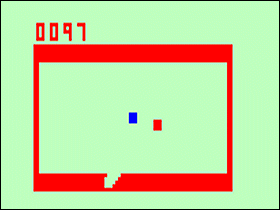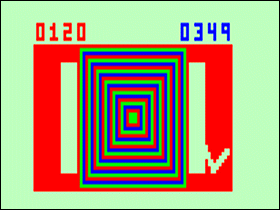 The Game: Trapped in a square or rectangular arena, the player is represented by a mobile square. Another projectile punches its way into the arena and begins ricocheting around; points accumulate rapidly the longer the player’s square avoids contact with the projectile, but starting at 200 points, an additional projectile is added every 100 points, each on its own chaotic, bouncing path. The game ends when the player inevitably collides with one of these projectiles. (Fairchild, 1978)
The Game: Trapped in a square or rectangular arena, the player is represented by a mobile square. Another projectile punches its way into the arena and begins ricocheting around; points accumulate rapidly the longer the player’s square avoids contact with the projectile, but starting at 200 points, an additional projectile is added every 100 points, each on its own chaotic, bouncing path. The game ends when the player inevitably collides with one of these projectiles. (Fairchild, 1978)
Memories: Nearly every system, no matter how obscure, has at least one unique game that’s worth seeking out both hardware and software, just to try it out and see how much fun it is. Some systems, like the Atari VCS and the Intellivision, have something like half a dozen “killer apps”. When I played Dodge It on the Fairchild Channel F, it was one of those occasions where I looked up at the clock, and realized two things: it was an hour later, and I was still playing Dodge It. It’s a unique concept that I hadn’t seen elsewhere, maddeningly simple and insanely addictive. Dodge It made it worth my while to have a Channel F hooked up in my game room.
 That’s a bit of a bold claim, sure, but this game is an incredibly fun test of hand-eye coordination, peripheral vision, and one’s ability to track multiple moving objects without colliding with any of them. Maybe that rather dry description isn’t good – it makes it sound like the player’s a lab rat – so I have to add the qualifier that it is fun. It’s a lot of fun, actually. Perhaps I’ve missed it, but I haven’t seen this game pop up on any other systems, which is a crying shame. The basic concept is easy enough to execute that this should be like Breakout – there ought to be an iteration of it, official or otherwise, on every console under the sun. But it’s not, and that’s okay too – I like underdogs, and the super-simple but addictive Dodge It may well be Channel F’s shining moment in the sun.
That’s a bit of a bold claim, sure, but this game is an incredibly fun test of hand-eye coordination, peripheral vision, and one’s ability to track multiple moving objects without colliding with any of them. Maybe that rather dry description isn’t good – it makes it sound like the player’s a lab rat – so I have to add the qualifier that it is fun. It’s a lot of fun, actually. Perhaps I’ve missed it, but I haven’t seen this game pop up on any other systems, which is a crying shame. The basic concept is easy enough to execute that this should be like Breakout – there ought to be an iteration of it, official or otherwise, on every console under the sun. But it’s not, and that’s okay too – I like underdogs, and the super-simple but addictive Dodge It may well be Channel F’s shining moment in the sun.
 The colorful screen-filling cacophony that takes place when the player finally succumbs to the computer’s barrage of ricocheting objects is actually impressive when one takes the other Channel F games into account. It reveals some usually well-hidden capabilities of a machine that, perhaps with some more marketing love (and money), should have been able to take on the Atari VCS in its early days. Dodge It is the kind of fun that the whole Channel F library should have been.
The colorful screen-filling cacophony that takes place when the player finally succumbs to the computer’s barrage of ricocheting objects is actually impressive when one takes the other Channel F games into account. It reveals some usually well-hidden capabilities of a machine that, perhaps with some more marketing love (and money), should have been able to take on the Atari VCS in its early days. Dodge It is the kind of fun that the whole Channel F library should have been.